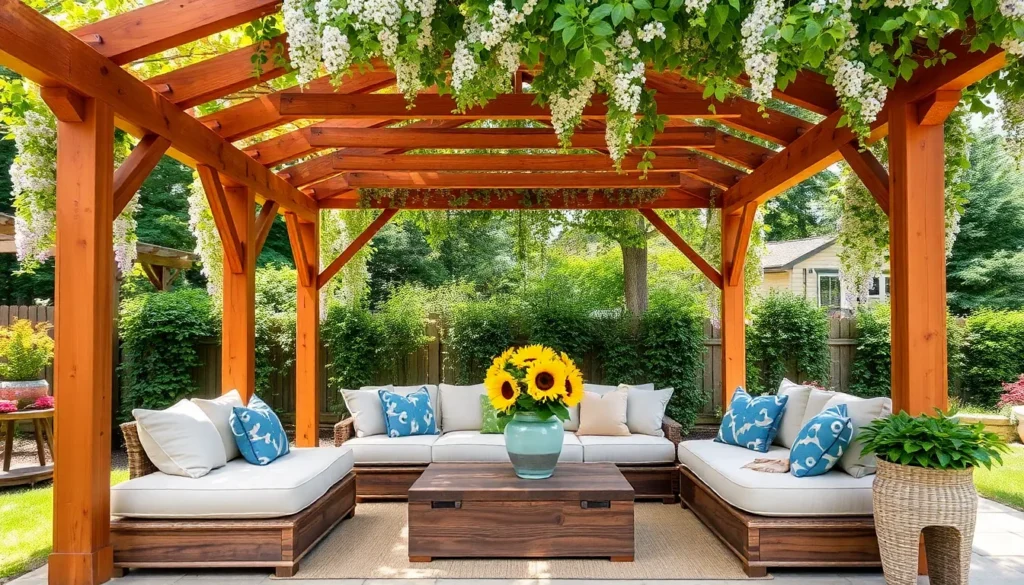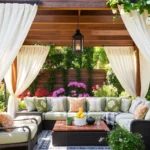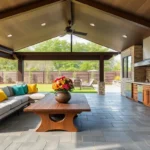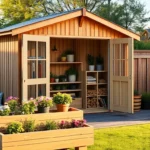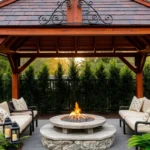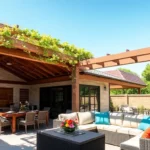Summer is the perfect time to embrace the great outdoors, but the blazing sun can often turn your backyard into an uninviting furnace. Whether you’re a seasoned gardener or new to outdoor living, our guide “15 Backyard Shade Ideas for Hot Summers” is your ticket to creating a cool, inviting oasis right at home. With a dash of creativity and a touch of practicality, you can transform your sun-drenched space into a shaded retreat, perfect for relaxation and entertaining.
From charming pergolas to lush leafy canopies, our expertly curated list is packed with innovative solutions that cater to every style and budget. You’ll discover practical tips and inspiring ideas that not only enhance your outdoor aesthetics but also offer refuge from the heat. Dive in with confidence, knowing that each idea is designed to bring you closer to the blissful joy of a beautifully shaded backyard sanctuary.
Install Retractable Awning Systems
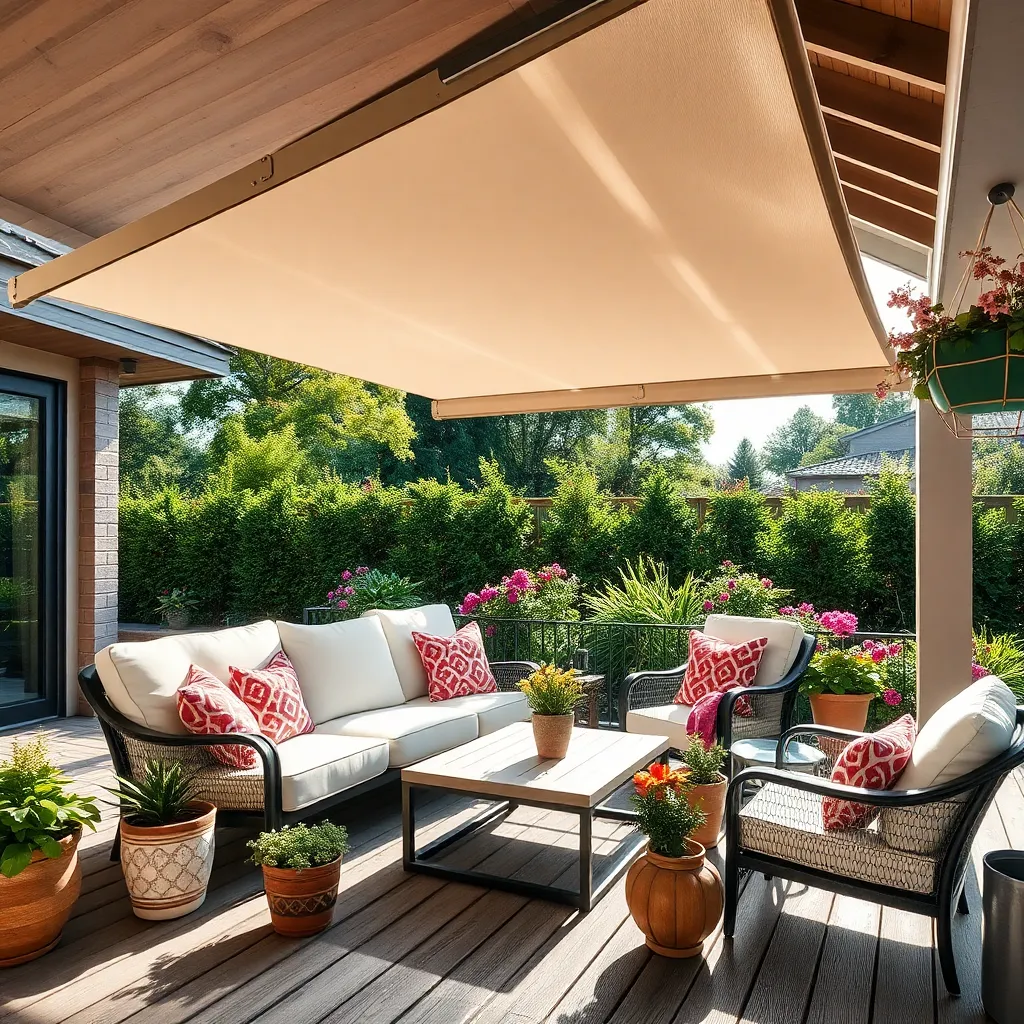
Installing a retractable awning system is an excellent way to introduce flexible shade options in your backyard. These systems allow you to enjoy the sun when you want it and create shade when needed, making them perfect for patios and decks. Choose durable materials like aluminum frames and UV-resistant fabric to ensure longevity. For beginners, a basic manual retractable awning can be a cost-effective choice, while more advanced systems offer motorized operation for ease of use.
Consider the size and placement of your awning to maximize its benefits. Measure your outdoor space carefully to ensure the awning provides adequate coverage. For a more seamless installation, look for awnings with built-in water drainage systems to handle rain efficiently. Experienced DIY enthusiasts might explore options to integrate lighting or heating elements, extending the usability of the outdoor space into cooler evenings. Implementing these features will not only enhance comfort but also add significant value to your home.
Create Pergola with Climbing Vines
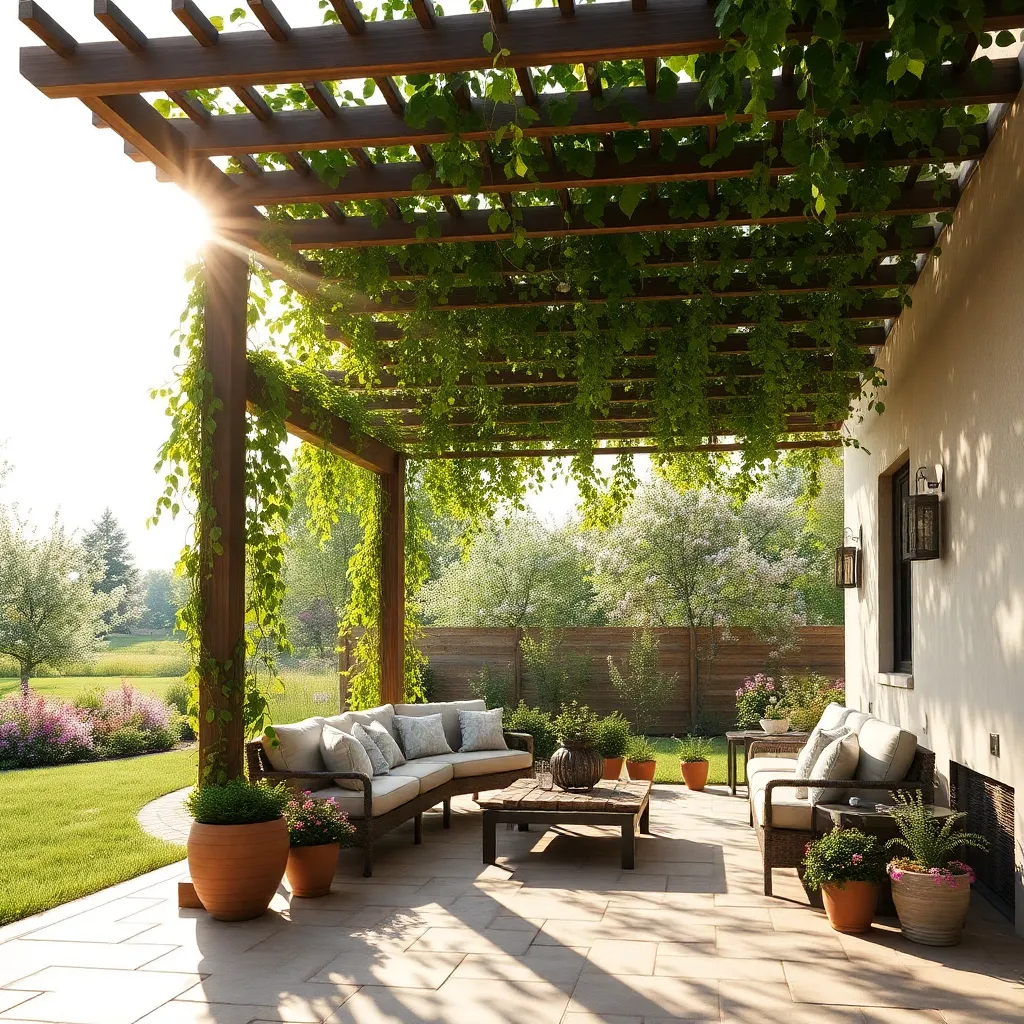
To create a pergola with climbing vines, start by choosing durable materials like cedar or treated lumber for the structure, which are both weather-resistant and visually appealing. Aim for a standard pergola dimension of about 8×10 feet, providing ample coverage and support for your vines. Securely anchor the posts into the ground using concrete for stability, especially in areas prone to strong winds. For beginners, consider starting with a pre-made pergola kit, which includes all necessary components and step-by-step instructions.
Enhance your pergola by selecting fast-growing climbing plants like wisteria or clematis, which thrive in full sun and provide excellent shade. Train the vines to climb by installing a simple wire trellis or lattice panels along the sides and top of the pergola. Water regularly during the establishment phase, and prune as needed to encourage healthy growth and coverage. For a more advanced touch, integrate solar-powered lights into the pergola beams to create a cozy evening ambiance.
Set Up Sail Shade Canopies
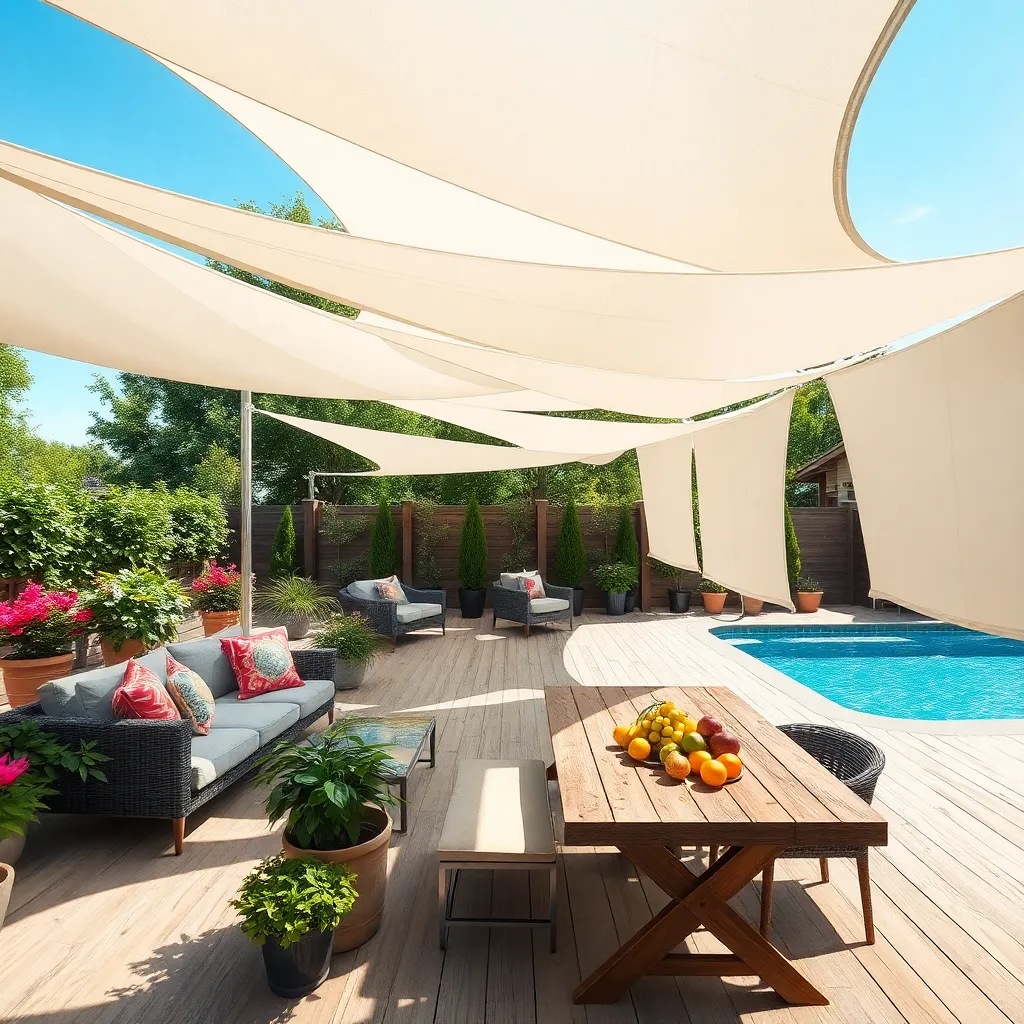
For a versatile and stylish way to provide shade in your backyard, consider setting up sail shade canopies. These canopies are made from durable, weather-resistant fabric that can withstand the elements while adding a modern aesthetic to your outdoor space. Start by identifying the areas you need shaded and measure the space to determine the appropriate size and shape of the sail. Popular shapes include triangles, rectangles, and squares, each offering different levels of coverage and visual appeal.
When installing sail shades, ensure you have sturdy anchor points, such as trees, posts, or the side of your house. Use high-quality stainless steel hardware like turnbuckles, pad eyes, and snap hooks to secure the sails tightly. For a professional finish, maintain a slight slope in the canopy to allow rainwater to run off easily. Advanced gardeners might consider layering multiple sails at different angles to create a dynamic and layered look that provides substantial shade and enhances the visual depth of their backyard.
Construct a DIY Bamboo Screen
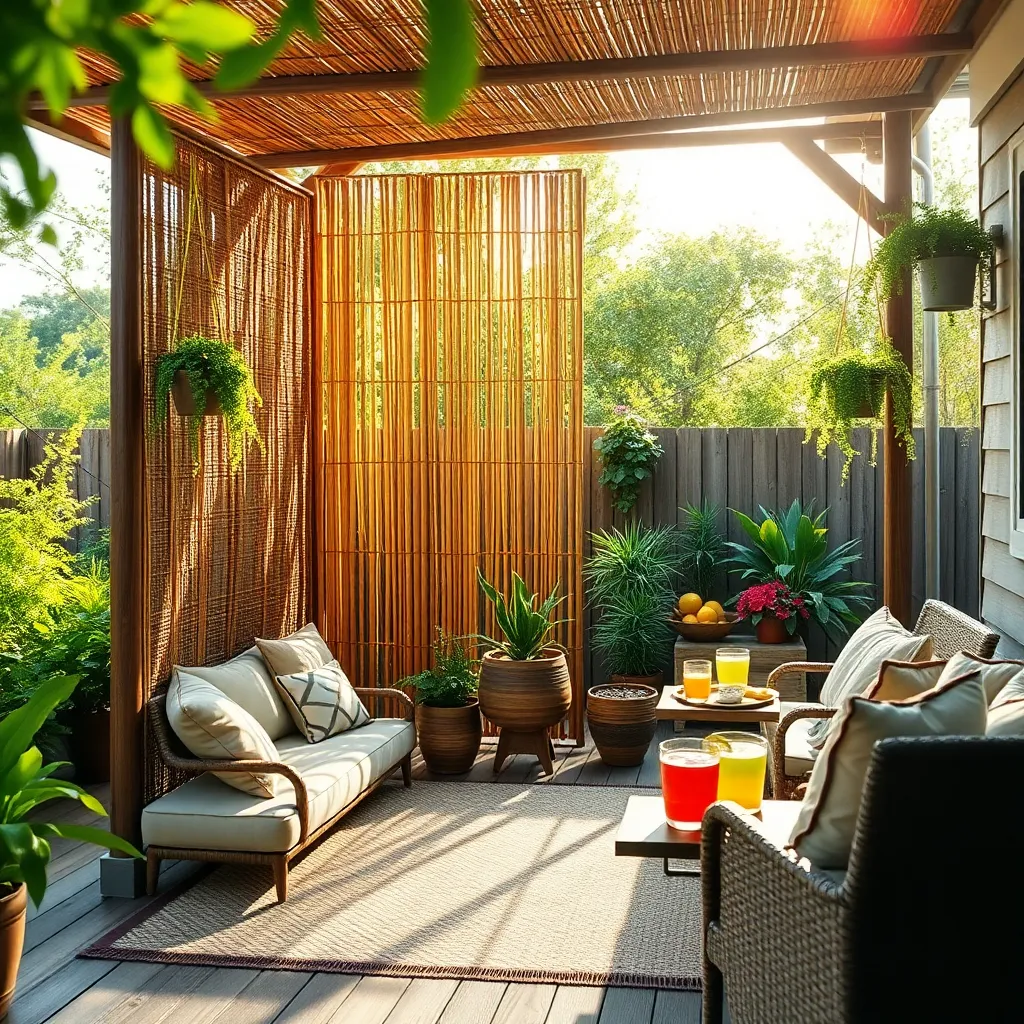
Creating a DIY bamboo screen is an excellent way to add shade and privacy while enhancing the natural beauty of your backyard. Start by sourcing sturdy bamboo poles that are at least 1.5 inches in diameter for strength and durability. Measure the area where you’d like to install the screen and cut the bamboo to your desired height, typically around 6-8 feet for optimal coverage. You can bind the poles together using strong weather-resistant rope or zip ties, ensuring they are tightly secured.
Position the bamboo screen along a fence or between two posts for stability. For added security and aesthetic appeal, consider anchoring the screen with decorative planters filled with sand or soil. Planting climbing vines around the base can further enhance the shade effect and integrate the screen into your garden’s landscape. For those looking to personalize their screen, try weaving colorful outdoor string lights or fabric through the bamboo for a unique touch that provides both function and flair.
Plant Fast-Growing Shade Trees

Planting fast-growing shade trees is an excellent way to create a natural relief from the sun in your backyard. Consider trees like the Red Maple or Silver Maple, which can grow up to 60 feet tall and provide extensive shade with their broad canopies. Choose a planting location that allows ample room for growth, ensuring the tree is at least 20 feet away from your home to prevent root interference and allow proper air circulation.
For a more immediate effect, you can plant a group of fast-growing trees, spacing them about 10 to 15 feet apart to create a dense canopy faster. Remember to use quality mulch around the base to retain moisture and reduce weeds, while keeping it a few inches away from the trunk to prevent rot. As your trees mature, consider pruning them annually to maintain their shape and promote healthy growth, ensuring they remain a valuable addition to your outdoor space for years to come.
Use Shade Cloth Over Patios
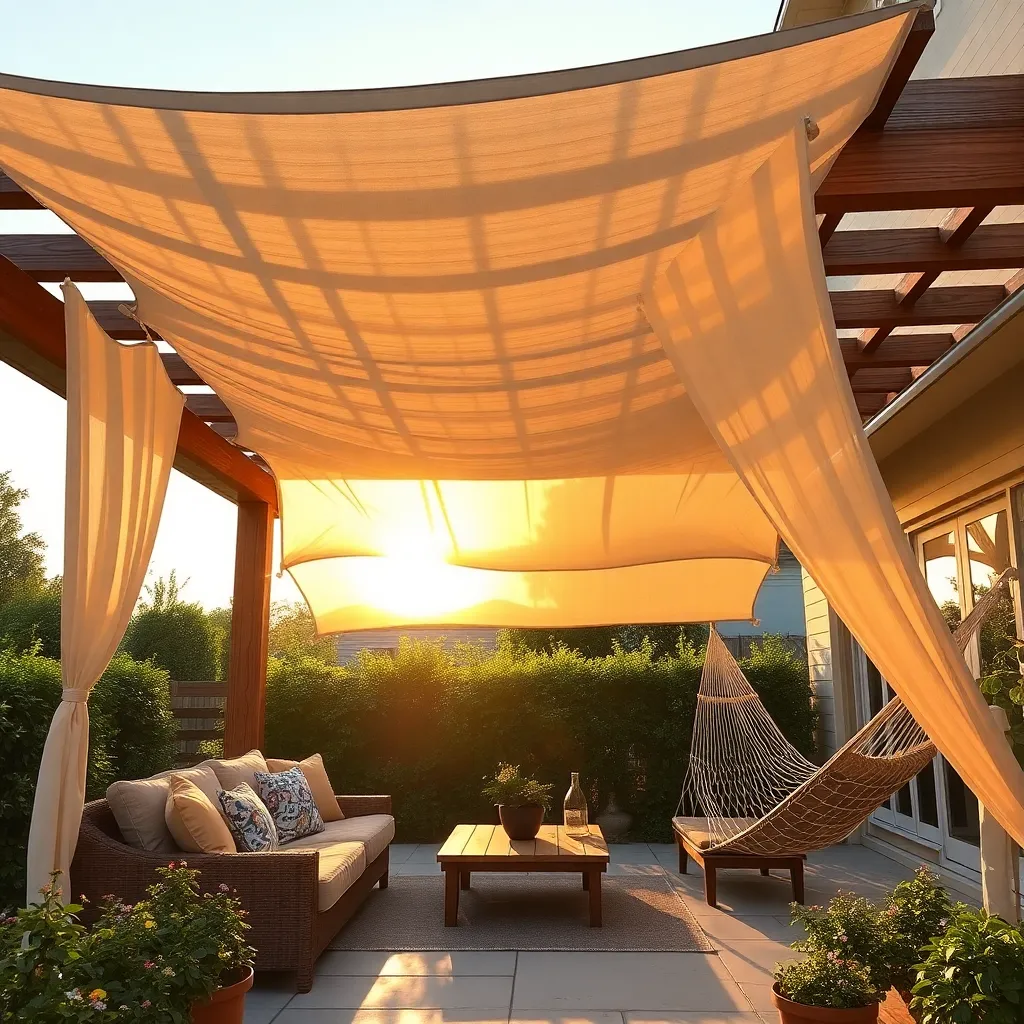
For an affordable and versatile way to add shade to your patio, consider using shade cloth. This material is available in various densities, allowing you to control the amount of sunlight you block. Choose a cloth with a density between 40% to 70% for most patio areas to balance shade and airflow. Secure the cloth with grommets and bungee cords or tie it tightly using UV-resistant rope to ensure it withstands wind and weather. This setup is perfect for beginners as it requires minimal tools and effort.
Advanced gardeners might explore incorporating shade cloth as part of a larger structure. For instance, building a wooden pergola and draping shade cloth over the top can provide both stability and a touch of elegance. Consider using a neutral-colored cloth to complement your outdoor decor, and think about adding retractable panels for adjustable shade. With these enhancements, you can create a dynamic and comfortable outdoor space that adapts to varying sun conditions, making your patio a cool retreat during hot summer months.
Build a Lattice Wall Structure
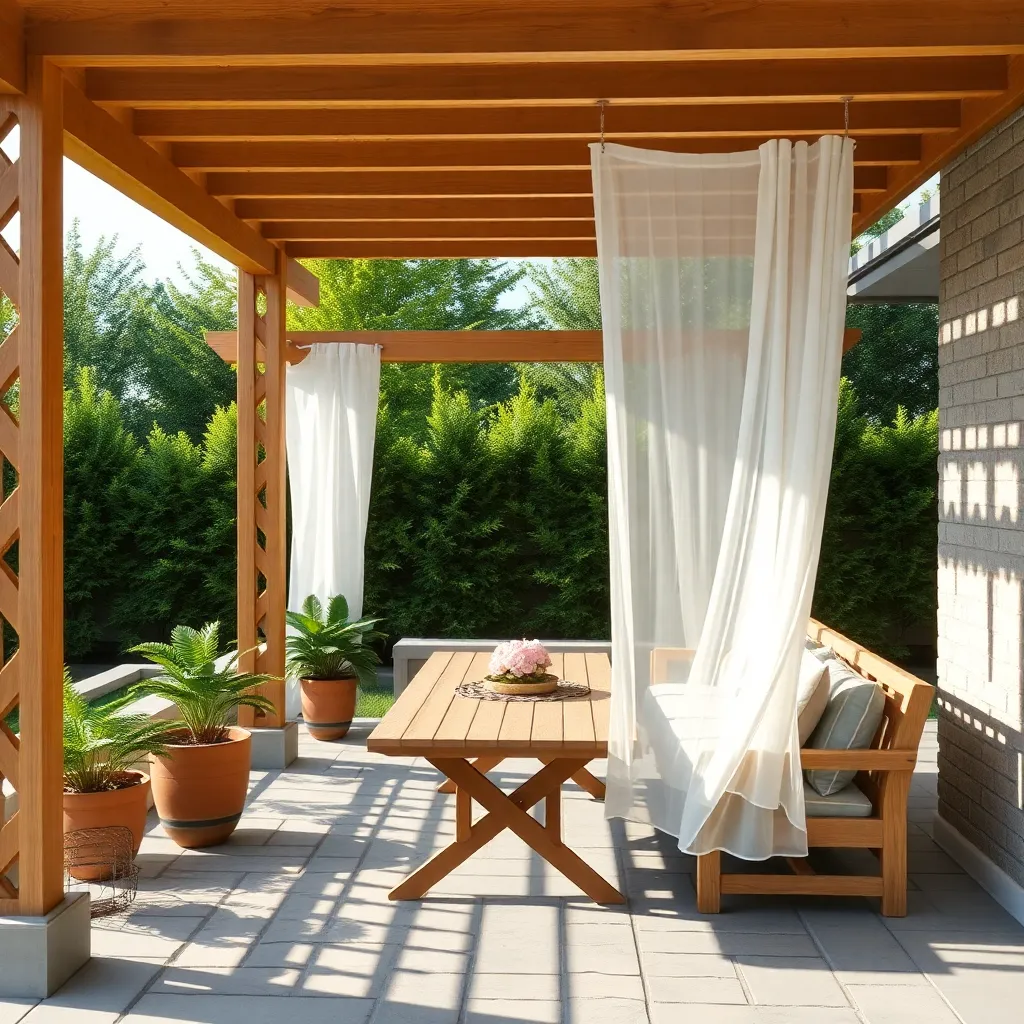
Transform your backyard into a cool oasis by building a lattice wall structure, an elegant solution for creating shade and privacy. Start with weather-resistant materials like cedar or pressure-treated wood, which are both durable and visually appealing. Use lattice panels measuring around 4×8 feet, which are readily available at most home improvement stores. Attach these panels to wooden posts embedded in concrete for stability, spacing them about 8 feet apart to ensure a sturdy framework.
Incorporate climbing plants like jasmine or clematis to weave through the lattice, naturally enhancing the shade over time. For beginners, ensure you use galvanized screws to prevent rust, and consider staining or sealing the wood to prolong its life. More experienced DIYers can add built-in planters at the base for an integrated look. This approach not only provides shade but also adds a touch of greenery and privacy, creating a peaceful retreat in your backyard.
Incorporate UV-Resistant Umbrellas
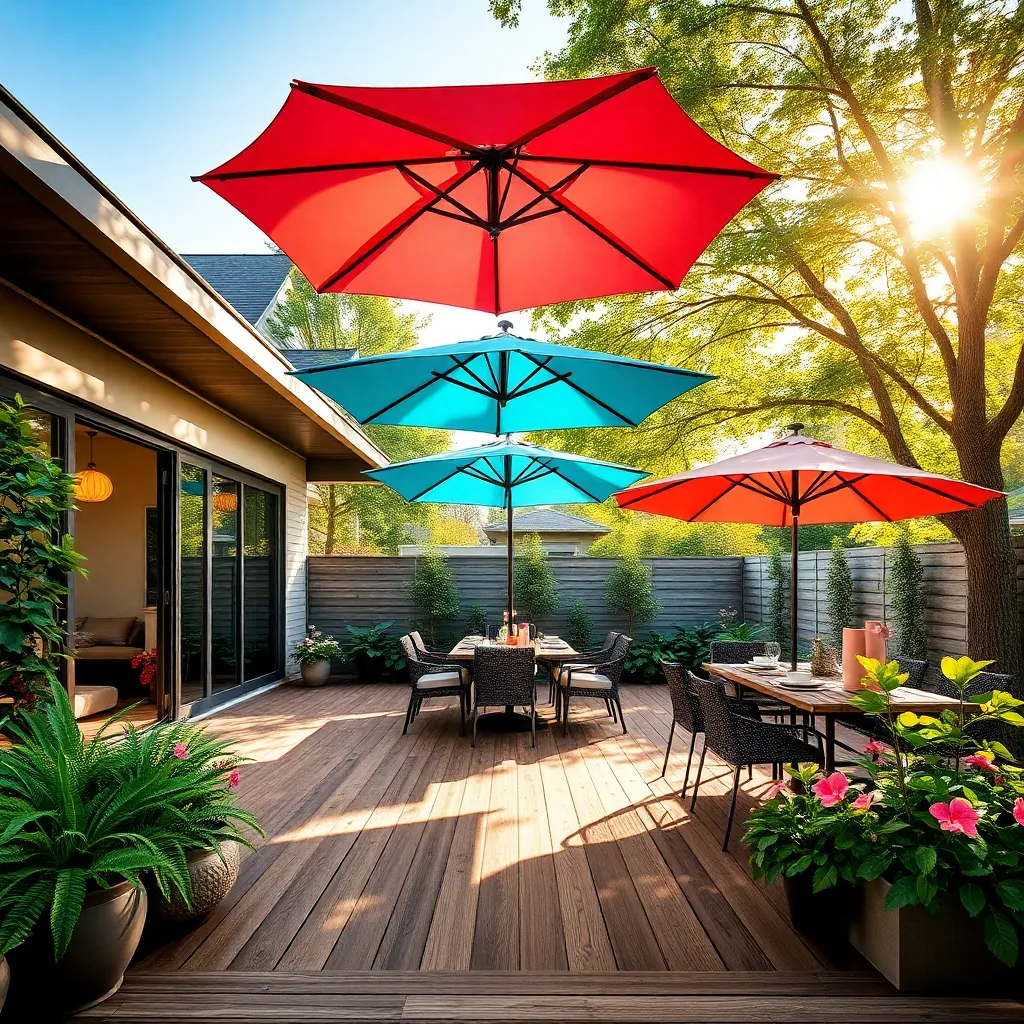
One effective way to add shade to your backyard is by incorporating UV-resistant umbrellas. These umbrellas not only provide relief from the sun’s harsh rays but also protect your skin from potential damage. When selecting an umbrella, choose materials like acrylic or polyester fabric, which are treated to block UV rays effectively. Opt for models with a tilting mechanism, which allows you to adjust the shade as the sun moves throughout the day, maximizing comfort and coverage.
For those looking to take their backyard design up a notch, consider investing in cantilever umbrellas. These offer more flexibility in positioning without a central pole obstructing the area, making them perfect for covering larger spaces like dining sets or lounge areas. Ensure the base is sturdy, ideally made of materials like granite or concrete, to withstand wind and weather changes. By selecting a vibrant color or pattern, you can also add a pop of personality to your outdoor setup, making it both functional and stylish.
Design a Covered Outdoor Lounge
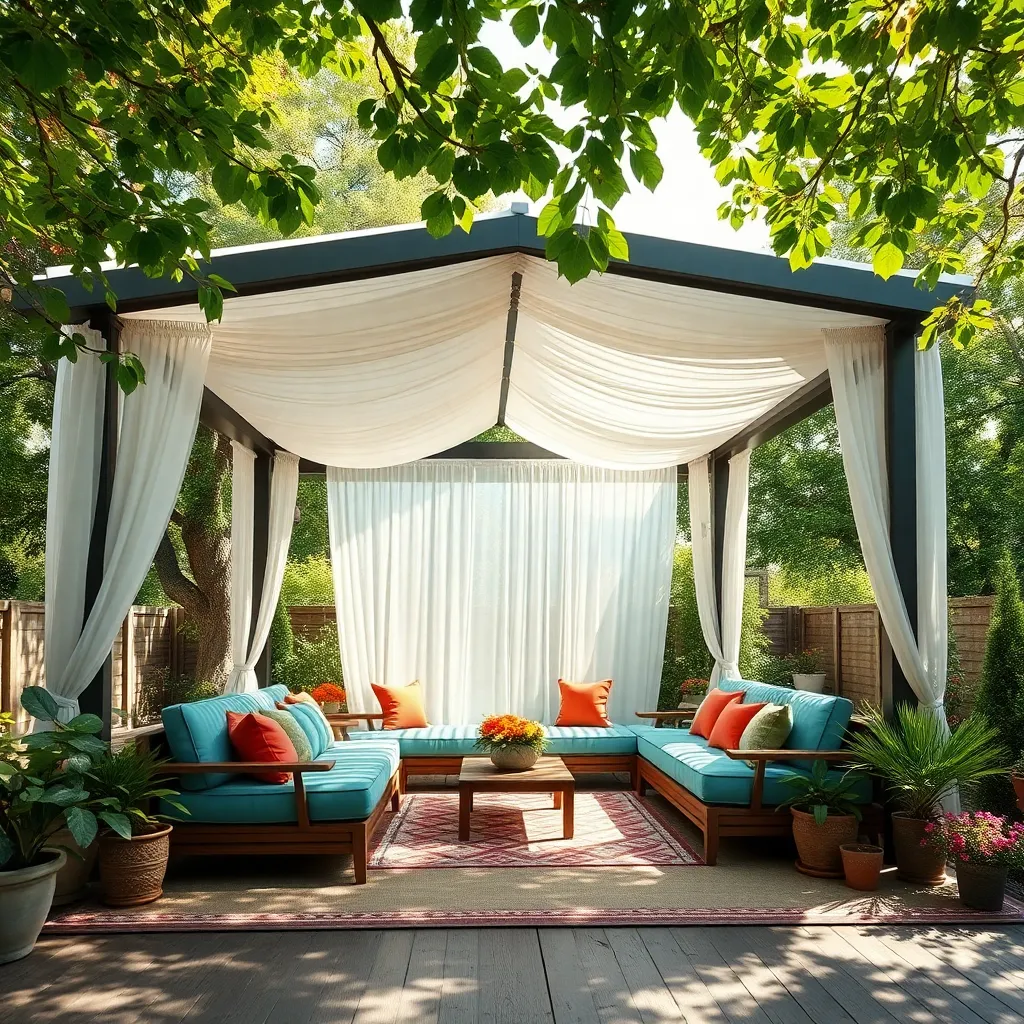
Creating a covered outdoor lounge starts with selecting the right materials to ensure durability and comfort. Opt for weather-resistant fabrics like acrylic or polyester for upholstery to withstand the elements. For the structure, consider using treated wood or powder-coated metal to prevent rust and decay. Proper dimensions are crucial; aim for at least 10×10 feet to comfortably fit furniture and allow for movement. Adding a ceiling fan or misting system can help keep the area cool on particularly hot days.
Design elements such as retractable awnings or pergolas with adjustable slats offer flexibility in controlling sunlight exposure. Consider installing LED lighting for evening ambience, and incorporate side curtains or shades for added privacy and protection from the sun. For a more advanced touch, integrate smart technology to control lighting and fans with your smartphone. Remember, the key is to blend functionality with aesthetics, ensuring your outdoor lounge is both beautiful and practical.
Opt for Pop-Up Gazebos
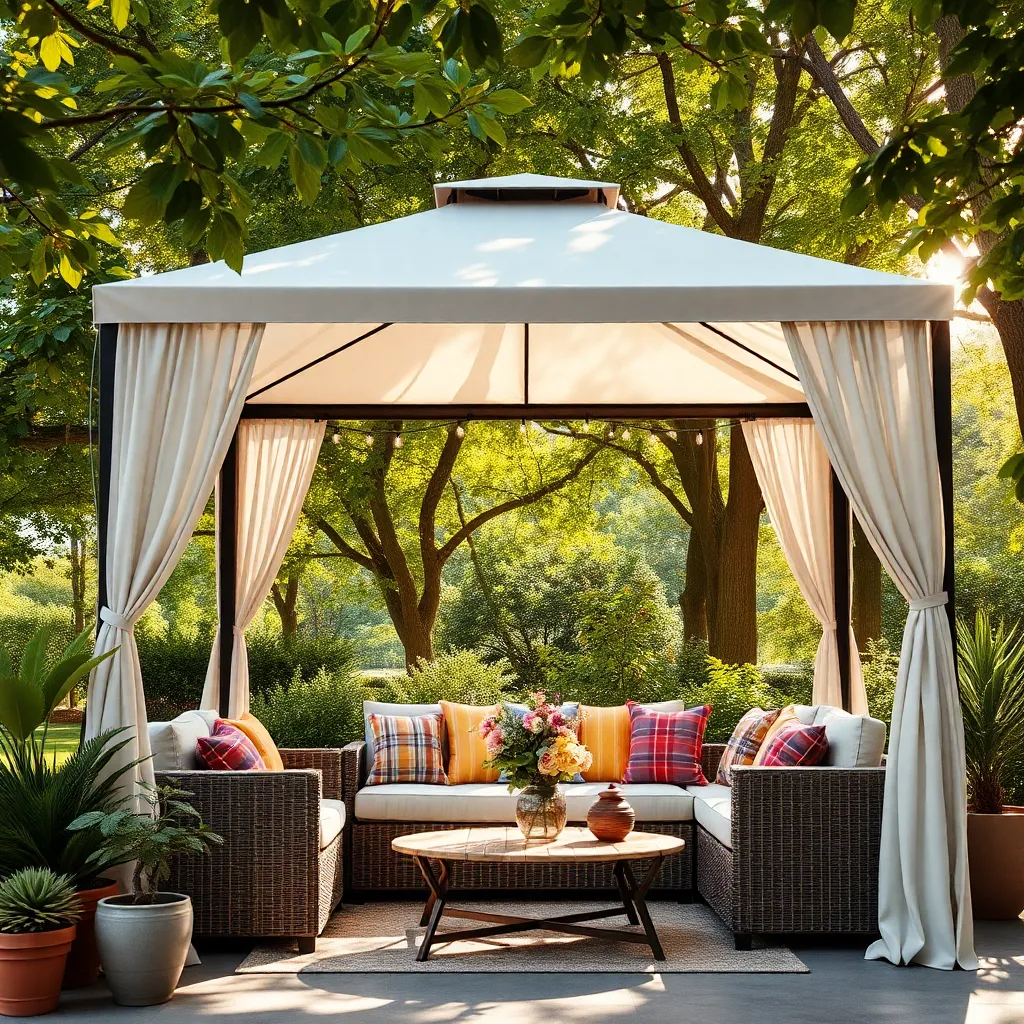
Pop-up gazebos are a versatile and convenient option for creating instant shade in your backyard. These structures are typically made from lightweight materials such as aluminum or steel frames and durable, waterproof fabric covers, making them easy to set up and take down. For beginners, start with a basic 10×10-foot size, which provides ample coverage without overwhelming your space. Ensure that the gazebo you choose has sturdy anchoring options, like pegs or weights, to keep it secure during windy conditions.
For those looking to elevate their outdoor experience, consider gazebos with additional features such as mosquito netting or side panels for enhanced comfort and protection. Advanced users can personalize their space by incorporating string lights or hanging plants from the frame for added ambiance. When selecting your gazebo, look for UV-resistant fabric to provide optimal sun protection, ensuring a cool and comfortable retreat during hot summer days. Whether hosting a garden party or enjoying a quiet afternoon, pop-up gazebos offer a flexible and stylish solution for any backyard setting.
Add a Wooden Trellis Roof
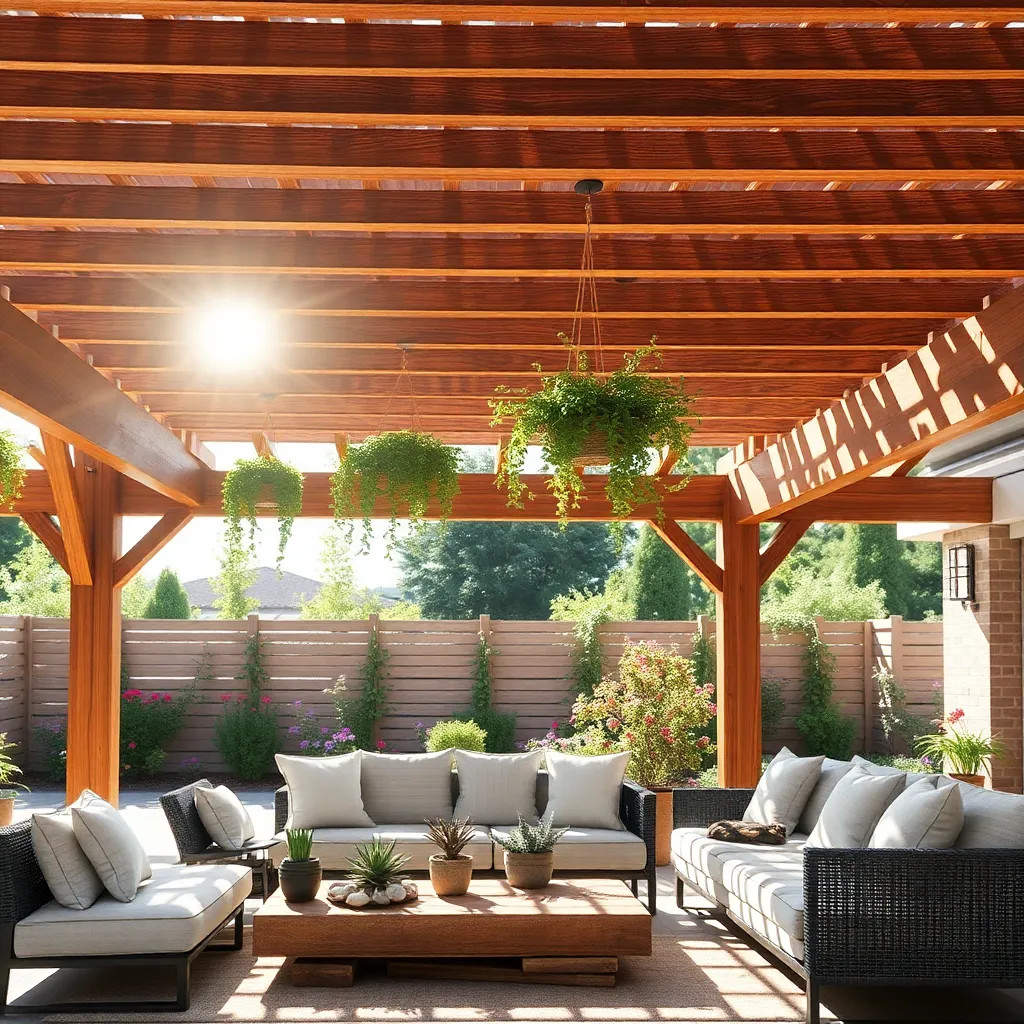
Adding a wooden trellis roof is a charming way to create shade while maintaining an open, airy feel in your backyard. For beginners, start with durable wood like cedar or redwood, which naturally withstands weathering. Opt for a simple lattice design with slats spaced 1 to 2 inches apart to provide partial shade while allowing light to filter through. This design not only offers relief from the sun but also doubles as a support for climbing plants like clematis or wisteria, adding a lush, living canopy over time.
For those ready to tackle a more advanced project, consider incorporating angled slats or decorative cutouts for a more bespoke look. Ensure your trellis is securely anchored to withstand wind and weather; using galvanized brackets and screws will enhance stability and longevity. When designing, aim for a height of 8 to 10 feet to ensure ample headroom and a comfortable, inviting space beneath. This structure not only provides shade but also elevates your outdoor aesthetic, making it a perfect blend of function and style.
Hang Outdoor Curtains Strategically
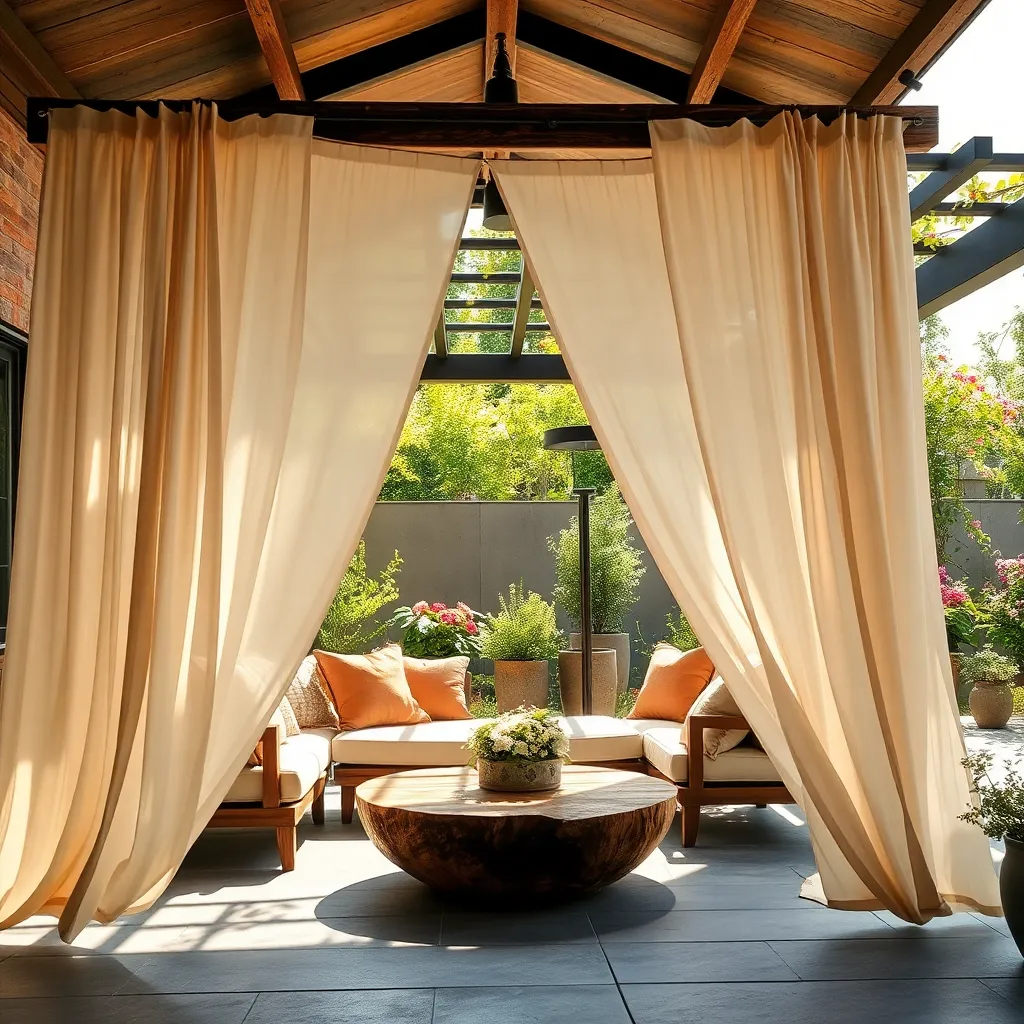
To enhance your backyard’s appeal while providing much-needed shade, consider hanging outdoor curtains strategically. Choose weather-resistant fabrics like acrylic or polyester that can withstand the elements and offer UV protection. Install curtain rods or cables along your pergola, porch, or patio to create a flexible and stylish shade solution. For beginners, ensure the rods are securely fastened using outdoor-rated hardware to withstand wind and rain.
Advanced gardeners can explore creative options by using curtain tiebacks or hooks to adjust light and airflow. Play with colors and patterns to complement your existing outdoor decor, creating a cozy, personalized retreat. For large spaces, consider using multiple layers or panels, allowing for more precise control of shade and privacy. This adaptable approach not only enhances comfort but also adds a dynamic visual element to your outdoor living area.
Erect a Rustic Pallet Pavilion

Repurpose old pallets to create a charming and functional rustic pavilion in your backyard. Start by selecting sturdy wooden pallets, ensuring they are heat-treated and free of harmful chemicals. You’ll need about 10-12 pallets for a small pavilion, depending on the size you want. Arrange them into a square or rectangular base, securing them with nails or screws for stability. For a more advanced touch, consider adding a polycarbonate roof to provide additional shade and protection from the elements. This roof material is lightweight, durable, and easy to install, making it perfect for DIY enthusiasts.
Enhance your rustic pavilion by incorporating natural elements and personal touches. Use climbing plants like clematis or wisteria along the sides for a lush, green canopy effect. For flooring, lay down gravel or outdoor-friendly rugs to define the space and add comfort. Beginners can keep it simple by adding a few comfortable chairs and a small table, creating a cozy nook for relaxation. Meanwhile, experienced DIYers might incorporate solar-powered lights or a small fire pit to extend the pavilion’s usability into the evening. With these simple steps, you can transform basic pallets into a personalized retreat that offers both shade and style.
Utilize Outdoor Roller Blinds
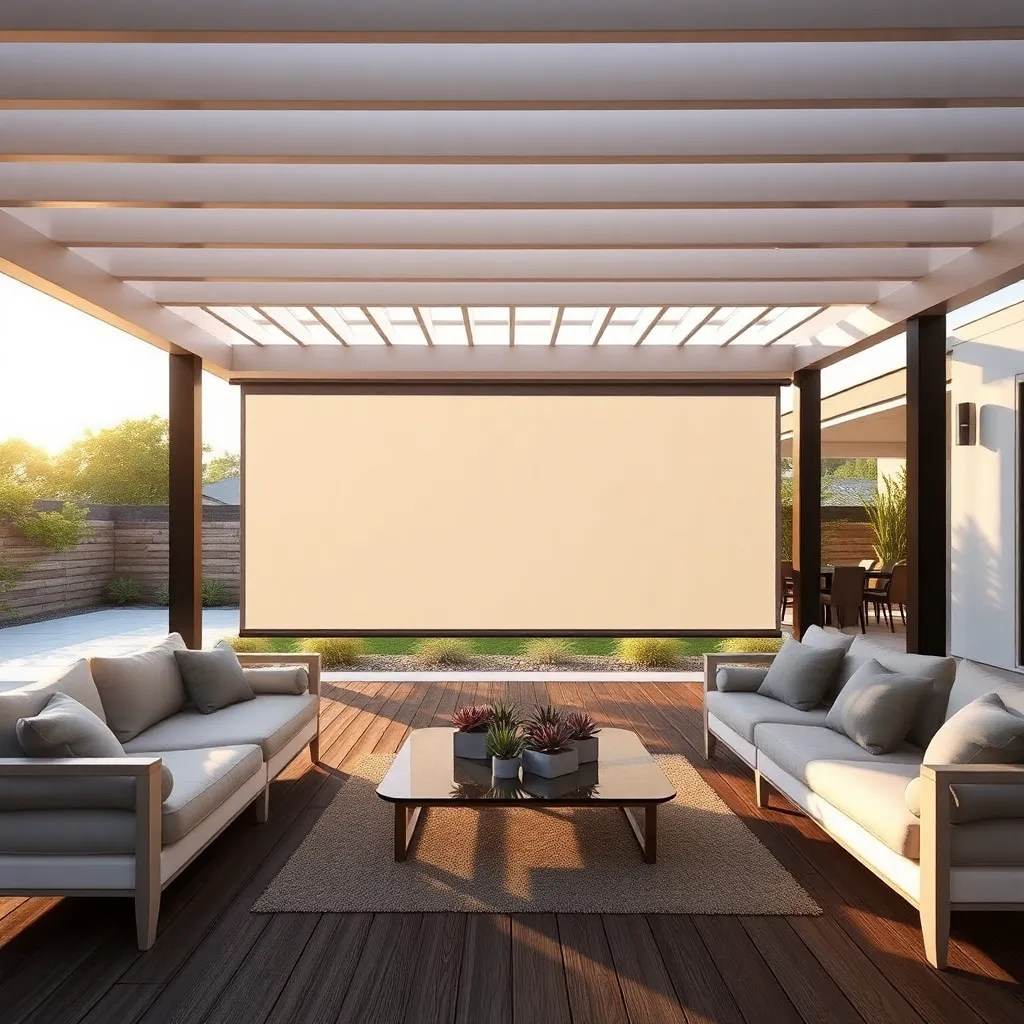
Outdoor roller blinds are a versatile solution to enhance your backyard’s shade, effectively blocking out intense sun while maintaining an open, airy feel. They can be installed on pergolas or patios, providing flexible coverage that you can easily adjust throughout the day. Choose durable materials like PVC or canvas that withstand the elements and offer UV protection. Basic DIY installation is straightforward, typically involving mounting brackets and a tensioning system to keep the blinds taut.
For a more polished look, consider roller blinds with motorized options, allowing you to adjust them via remote control or even integrate with smart home systems. Advanced users might explore solar-powered models, which are environmentally friendly and reduce energy costs. Ensure the blinds’ dimensions are slightly larger than your space to maximize coverage, and look for designs with side tracks to prevent flapping in windy conditions. With these practical options, your backyard will be both functional and inviting throughout the hot summer months.
Grow Tall Hedge for Privacy Shade
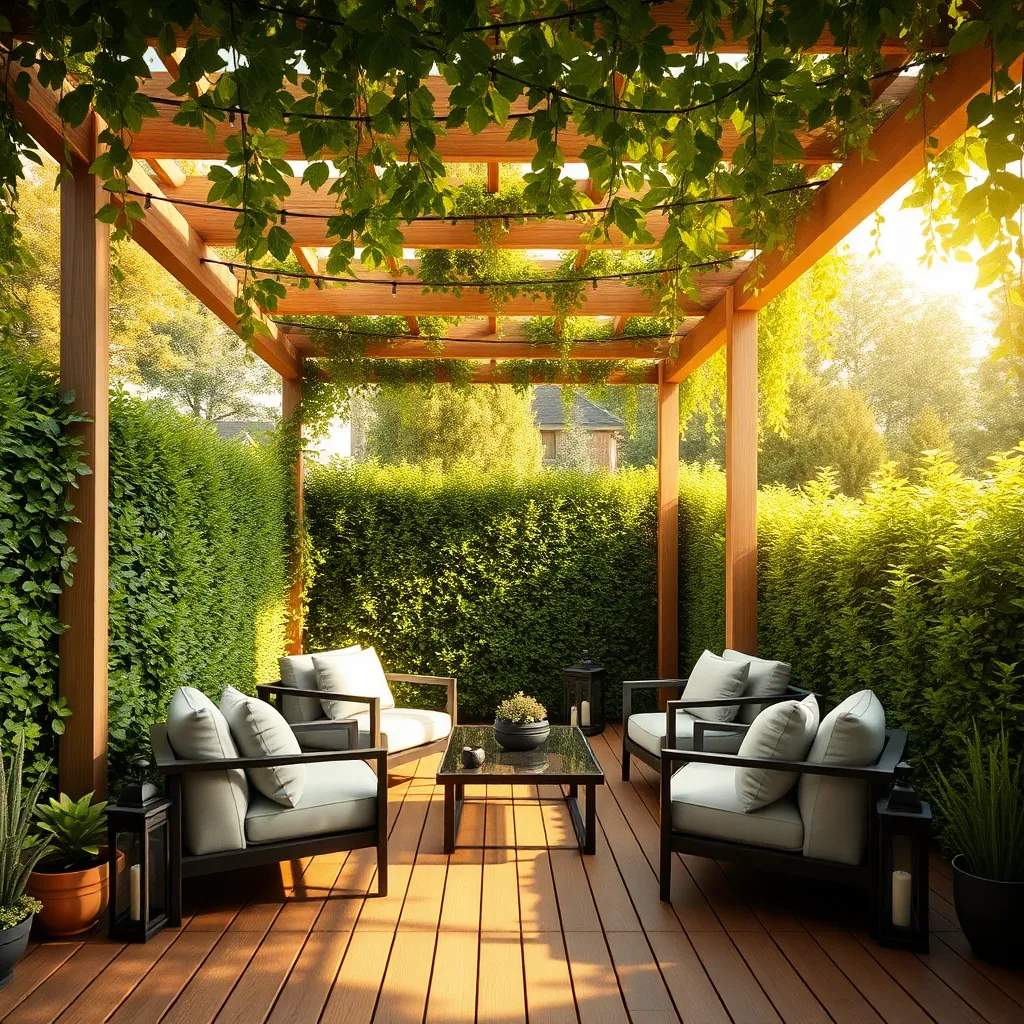
Creating a tall hedge for privacy shade is an excellent way to enhance your outdoor space while providing relief from the summer sun. Start by selecting plants that grow densely and quickly, such as Thuja Green Giant or Leyland Cypress, which can reach heights of 20 to 30 feet. These evergreens are ideal for year-round coverage and can be planted in a row, spaced about 3 to 5 feet apart for optimal growth. For beginners, ensure the soil is well-draining and enriched with organic matter to give your hedge the best start.
For a seasoned gardener, consider mixing different species to add texture and interest to your hedge, such as alternating between Holly and Privet. When planting, use a string line to keep your row straight, and maintain a regular trimming schedule to encourage bushier growth and maintain your desired shape. If you’re aiming for a more sophisticated design, incorporate a layering technique by planting taller trees behind shorter shrubs, creating a tiered effect that maximizes both privacy and shade.
Conclusion: Creating Beautiful Outdoor Spaces
In the quest to create a harmonious and inviting backyard oasis, our exploration of 15 innovative shade ideas serves as a delightful metaphor for nurturing the important relationships in our lives. From the intimacy of pergolas and the reliability of retractable awnings to the nurturing embrace of shade sails and natural tree canopies, each concept reflects the diverse ways we can provide comfort, protection, and beauty in our personal connections. Just as these backyard solutions offer respite from the summer heat, thoughtful gestures and intentional time can strengthen our bonds, providing shelter from life’s inevitable storms.
As a next step, consider which shade solution best mirrors your current relationship needs. Is it the stability of a permanent structure or the flexibility of a temporary option? Begin a conversation with your loved one about how you can implement this idea both physically and metaphorically.
For continued inspiration and guidance, be sure to bookmark this article. By keeping these insights at your fingertips, you’ll have a ready guide to revisit as your relationships evolve. Remember, like a well-shaded backyard, a thriving relationship requires ongoing care and creativity. With these tools, you’re well on your way to cultivating lasting connection and joy.

